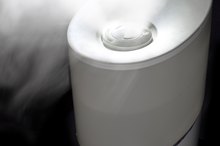What Are the Dangers of Fabric Softeners?
Fabric softeners help keep clothes soft and colorful 3. While many people use fabric softeners while they do their laundry, most are unaware of the chemicals that softeners use. Many softener manufacturers do not go into detail about the compounds they use to help soften fabric. Unfortunately, many softeners are made from a wide mixture of chemicals that can have potentially hazardous effects on the human body over time.
Irritation
Fabric softener companies do warn that their products can cause irritation, especially the liquid versions, and advise that you do not allow any fabric softener to touch your skin or your eyes. Some of the chemicals used to create these softeners are caustic and can cause itching or burning problems when the products accidentally contact skin.
Respiratory Problems
Breathing Ionizer Dangers
Learn More
Other chemicals in fabric softeners can cause lung problems and more significant irritation if they are inhaled. Benzyl alcohol, a common ingredient, acts as an upper respiratory tract irritant, while other compounds like A-Terpineol and pentane can also cause lung damage. These chemicals can cause asthma, especially in younger children.
Carcinogens
Carcinogens are compounds that have been linked to causing cancer. It is difficult to pinpoint the substances that can actually cause cancer, and those linked to sufficient evidence are often banned (like asbestos). However, other chemicals may have been linked to cancer in some studies but have not yet been examined thoroughly enough to determine a direct link. Chemicals like chloroform and limonene are known as carcinogens and show up in fabric softeners.
- Carcinogens are compounds that have been linked to causing cancer.
- It is difficult to pinpoint the substances that can actually cause cancer, and those linked to sufficient evidence are often banned (like asbestos).
Nervous System Damage
Chemicals in Sanitary Pads
Learn More
Many of the compounds that cause skin irritation or may increase the possibility of cancer can also have a cumulative toxic effect if they are accidentally ingested. Ethanol, camphor and linalool can all cause nervous system damage. So can the previously mentioned chloroform and A-terpineol. Toxin exposure results in symptoms including dizziness, nausea, headaches, numbness and pain in the neck and spine.
- Many of the compounds that cause skin irritation or may increase the possibility of cancer can also have a cumulative toxic effect if they are accidentally ingested.
- Ethanol, camphor and linalool can all cause nervous system damage.
Fabric Problems
Some fabric softeners use tallow, a waxy material that can help protect clothing and keep it from being damaged as easily by stains. However, tallow can also render towels ineffective at absorbing water; since tallow repels liquids, towels can struggle to perform their jobs in bathrooms and kitchens. Tallow is also dangerous for the dryer lint filter, where it can cause clogging issues.
Chronic Maladaptation
The human nervous system develops a condition when constantly exposed to the toxic chemicals that fabric softeners leave in clothing, becoming chronically maladapted to their presence 3. The effect the toxins have on the nervous system, though negative, can create an addictive-type response when they are constantly present. The nervous system begins to expect the toxins to be there and someone affected may not associate problems with fabric softener products, even on a physical level. This problem is exacerbated by fabric softeners that impregnate fabrics and continue to release their compounds over a long period of time 3.
Related Articles
References
- Sixwise: The Toxic Danger of Fabric Softener and Dryer Sheets
- Homeairpurifierexpert: Dangers of Fabric Softener - Airing the Dirty Laundry
- Greenandchic: Alternatives to Fabric Softeners
- University at Buffalo Center for Integrative Medicine: Environmental Medicine, Cleaning Agents
- Environmental Health Association of Ontario: Health Risks of Fabric Softeners
Writer Bio
Tyler Lacoma has worked as a writer and editor for several years after graduating from George Fox University with a degree in business management and writing/literature. He works on business and technology topics for clients such as Obsessable, EBSCO, Drop.io, The TAC Group, Anaxos, Dynamic Page Solutions and others, specializing in ecology, marketing and modern trends.









